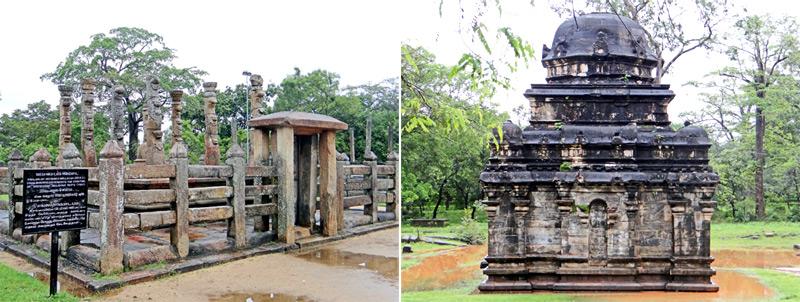
Polonnaruwa is the second largest ancient historical capital city of Sri Lanka which flourished during the 11th and 12th century. The city is close to the longest river in Sri Lanka, the Mahaweli Ganga.
To the Western boundary of this ancient historical capital is the largest manmade reservoir the Parakrama Samudra. This was built by King Parakramabahu 1 in the 12th century. The Parakrama Samudra originally consisted of five large reservoirs or wewas named Thopa Wewa, Eramudu Wewa (Katu Wewa), Dumbuthulu Wewa, Kalahagala Wewa and Bhu Wewa. Polonnaruwa is a designed city with a rectangular configuration. The North South axis of the city is defined with three distinct areas, the royal precincts, inner city and outer city.
Historical monuments
All are protected by brick walls. Many of the buildings were designed and constructed more than 800 years ago. Even the city is surrounded by excellent ancient buildings which are now protected and preserved in the form of ruins by the authorities. All these excellent historical monuments provide an opportunity for archaeologists and art historians to understand the ancient historical, social and cultural values of architecture in ancient Polonnaruwa.
The buildings were decorated with sculptures, paintings and mouldings, irrespective of the fact whether they are secular or religious buildings in nature. Today more than hundreds of buildings are seen in and around the vicinity of Polonnaruwa. All the buildings stand as evidence for one to understand the art and architectural achievements of the Polonnaruwa period in Sri Lankan history.
Among them, some of the remarkable ancient architectural structures of Polonnaruwa are the royal precincts of Polonnaruwa, the remains of the seven storey palace of Parakramabahu, beautifully carved stone based council chamber, royal ponds with stone sculptural decorations, many other residential and ancillary buildings of the palace. Just outside the main gate of the palace house complex with more than 25 acres of land, is the temple square.
This is known as the Dalada Maluwa. It consists of many important Buddhist religious buildings made out of bricks and stones. The building structures represent the architectural achievements of the Polonnaruwa period. All the architectural achievements were decorated with incomparable stone and stucco carvings.
Architecture
Atadage, Hetadage, Nissanka Latha Mandapa, Vatadage, Gal Potha, Thuparama and Sathmahal Prasada still serve as outstanding evidence for Buddhists architectural structures of the Polonnaruwa period. Within the inner city there were five Hindu temples dedicated to Gods, Lord Siva, Lord Visnu and Lord Ganesha. Even outside the inner city, many more temples were dedicated to Lord Siva. In addition to the architectural sculptures, in and around the Hindu temples and Hindu temple environs, a large number of bronze icons and stone statues were discovered.
The bronze and stone statues were excavated by the Department of Archaeology and Central Cultural Fund. The sculptures provide information about the religious and cultural practices which prevailed during the Polonnaruwa period. To the North of the city, there are many Buddhist monastery complexes including stupas, image houses, ponds and other ancillary buildings. This date, all the buildings stand as historical evidence for one to understand the ancient glories and architectural heritage of ancient Polonnaruwa.
Large Buddhist image houses were built by bricks with excellent and exquisite architectural designs and decorations. Outer walls of the architectural structures were decorated with bas reliefs and paintings. All the secular and religious buildings of Polonnaruwa provide vital information for one to understand the aesthetic principles which guided the ancient architects and artisans of Polonnaruwa.
Sculptures and paintings
Polonnaruwa served as a seat of governing in Sri Lanka for more than two centuries. This is known as the Polonnaruwa period in the Sri Lankan history. Prior to this period was the Anuradhapura period from the 6th century BC to the11th century A.D. During this period, Sinhala Buddhist artistic architecture, sculptures and paintings were in practice.
For easy reference and study, historians have divided the historical chronology into periods in relation to the political periods of the country. In in Sri Lankan’s history, the Anuradhapura period, continuously served as the capital for more than 1,200 years to 1400 years. This period is known as the glorious period in the Sri Lankan’s history.
The Anuradhapura period was followed by the Polonnaruwa period, where Polonnaruwa was functioning as the capital for nearly 215 years. Later the capital was shifted towards the South, to Dambadeniya, Kurunegala, Yapahuwa, Gampola, Raigama, Seethawaka, Kotte, Kandy and Colombo.
The Polonnaruwa period started with the Cholas and ended with Kalinga Magha (Kalinga Vijayabahu). In the late Anuradhapura period, slowly and gradually the South Indian invasion and penetration took place.
As a result, the Polonnaruwa kingdom was subjected to South Indian religious-cultural, social and political influence. During this period art and architecture were deeply influenced by the South Indian practices.
There were two great kings in Polonnaruwa the Vijayabahu 1 and the Parakkramabahu 1. King Nissankamalla was also a popular king during this period. Polonnaruwa Capital was devastated by another foreign invasion under the Kalinga Magha and later the capital was shifted to Dambadeniya.
Chola period in Sri Lankan history is very important because of the opening years of the Polonnaruwa period in Sri Lanka started with Chola regime and they ruled for more than five decades.
